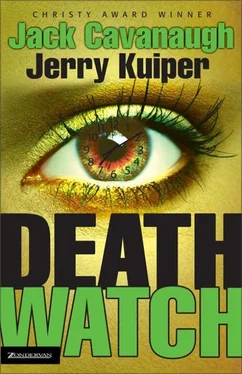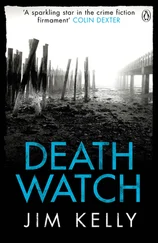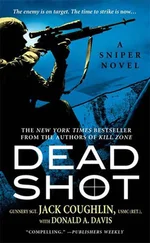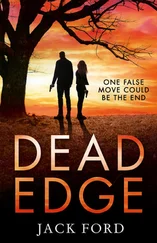He flipped on lights as they went from room to room, passing through a kitchen that was orderly and clean. A single plate, cup, fork, and knife had been washed and were in the dish drainer. A new liner was in the trash can.
“For a man who lives alone,” Sydney said, “you sure keep everything spick-and-span.”
Vandeveer stopped and looked at her. He smiled. “Haven’t heard that phrase in years. My mother used to use it.”
He flipped on a light switch in the next room. A spacious area came alive with scenic color.
“Oh my, this is lovely!” Sydney said.
Two concrete steps led down to a room addition that looked like it had once been a recreation room. Now it was a miniature countryside, complete with mountains, bridges, valleys, and streams.
“This is what keeps me busy,” he said.
Model train tracks wove their way through a miniature countryside that was intricately detailed with trees and bushes. Figures created mini scenes: a train station with a man reading a newspaper on a bench; a line of people purchasing tickets, with a woman holding a child’s hand; and another scene with people on an embankment, waving to a passing train.
In one corner of the room there was a workbench with a magnifying-glass light on an arm, bottles of model paint, brushes, pictures everywhere, and stacks of magazines— Great Model Railroads, Model Railroader, and Trains.
With shaking hands Vandeveer donned a blue-and-white-striped engineer’s cap. He settled down into an overstuffed chair. There was an identical chair beside it, which he offered to Sydney. Hunz started to sit on the wooden stool at the workbench, then hesitated, checking it first. He was obviously worried about getting paint on his suit pants.
The paramedics entered the room, carrying boxes of medicine and equipment.
“We’re going to hook you up to an EKG so we can monitor your heart,” Sydney said. “The paramedics will also monitor your vital signs. Blood pressure. That sort of thing.”
One of the paramedics asked Vandeveer to take his shirt off.
Vandeveer looked at him with wide eyes. “Can I keep this one on?” He tugged at the open flannel shirt.
The paramedics hooked him up, checked his vitals, and took a history. Vandeveer’s blood pressure was elevated, but not to the point of concern. His medical record showed him to be in good health. There was no reason for this man to die tonight.
On the wall was a clock, an oversized pocket watch complete with chain, the kind old-time stationmasters used to keep trains on schedule.
It read 8:17 p.m.
According to his death watch notice Lyle Vandeveer had one hour and forty-eight minutes left to live.
“It’s not a very good layout.” Vandeveer gestured toward the model countryside.
Hunz had left the room, saying he wanted to check on the security guards. Three were posted outside. One was in the kitchen.
Checking on the guards was obviously an excuse. Hunz used his cell phone to contact his people in Germany. A nine-hour span of time separated them, which meant the early-morning news team at EuroNet was already at work. Sydney figured Hunz wanted to find out if the station had developed any new leads on the death watch phenomenon.
“Why would you think this isn’t a good layout?” Sydney said. “It looks impressive to me.”
Vandeveer shook his head. “To be a top-notch layout, all the elements should have a unifying theme. The time period, the geographical setting, the architecture, the scenery, the people—all of it should be influenced by the type of railroad you’re running. This is just a hodgepodge of things I like. Sort of a picture postcard of my ideal world, I guess.”
Sydney walked over to get a closer look. Vandeveer’s world was orderly, colorful, and serene. All the resin figurines appeared content. Happy.
Vandeveer, standing beside her, pointed out his scale locomotives and cars, the precision of the re-creation, the separately applied handles, the real metal springs on the trucks, the directional lighting, and the five-pole skewed armature motor with dual flywheels for optimum performance at all speeds. “Museum quality,” he said with pride. He calmed as he talked about his trains.
He ran the train, making sure she listened to the authentic sound of the locomotive bell and whistle, the squealing brakes, and the Doppler effect.
The film crew captured it on tape.
“Some people go overboard with all this,” Vandeveer said, “the historical detail, precision re-creation of a time period. Some guys run their trains precisely on a designated schedule. I know one man who synchronizes his pocket watch with the atomic clock at the Naval Observatory every morning. That kind of detail takes all the fun out of it for me.”
Sydney looked at the wall clock.
8:55 p.m.
At 9:05 p.m., precisely one hour from the death watch time, the medical technicians gave Vandeveer another checkup. The results were the same. He was in good health.
“Tell you one thing,” Vandeveer said from his chair. “If I’m gonna go, this is where I want to be, with my trains and a pretty young thing at my side.”
He reached over and patted Sydney’s hand.
She didn’t mind. “Tell me about your family,” she said.
Vandeveer glanced at the clock, looked at her, and took a deep breath. “Outlived two wives,” he-said. “The first died early. We hadn’t been married two years.”
“I’m so sorry,” Sydney said. “That must have been difficult for you. Was it sudden?”
“Cancer. She was dead two months after they discovered it.”
“What was her name?”
He smiled. “Mildred. Great gal. Guess when we were married.”
Sydney leaned forward. “When?”
“November 22, 1963.” He laughed.
“The day Kennedy was shot.”
Vandeveer raised a lecturing finger. “Learned a lesson that day. Never get married on the day a president is assassinated. Makes for a lousy wedding reception.”
“That must have been horrible for Mildred!”
“She was a trooper. Big gal. Strong. She was one of those girls who could handle anything. I always thought she’d outlive me by a couple of decades.” He drifted away for a moment, caught up in a private memory of Mildred. “Anyway,” he said, “a year and a half later, I married her best friend, Bea.”
“You knew Bea when you were married to Mildred?”
Vandeveer grinned. “Mildred’s maid of honor. Close as sisters. They used to talk about me. Anyway, we had a daughter, Cindy. That’s her.” He pointed to a framed picture on his workbench. A happy young woman with bangs and a dazzling smile. It looked like a high school yearbook photo.
“Where is Cindy now?”
A shadow passed over Vandeveer’s face.
“With her mother,” he said.
“Oh, I’m sorry,” Sydney said. “I didn’t know.”
“Lost both of them on the same day in that airbus crash in Queens, November 12, 2001.”
“Oh, my.”
“Yeah. Cindy worked at the museum in New York. She restored old paintings. You know, spruced them up, took off layers of dust and grime, that sort of thing. We thought it was funny that she chose that particular profession since we couldn’t get her to clean her room.”
Sydney’s heart went out to this man who was so well acquainted with grief. In his perfect world, the one through which his model trains traveled, there was no hint of his pain. All the figurines were smiling.
“Bea flew out there to visit Cindy. We hadn’t seen her in a couple of years, and Cindy kept hounding us to come to New York.”
“Why didn’t you go?”
“Couldn’t get the time off. You see, the trip was supposed to be more than just New York. Bea had always wanted to see the Caribbean. She said, ‘You can have Paris and London and Rome. Before I die I want to see the Caribbean.’” Vandeveer’s eyes teared.
Читать дальше












